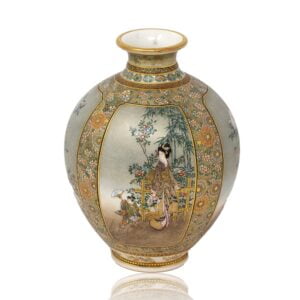Description
“Indien à cheval” (“Indian on horseback”)
From our Sculpture collection, we are delighted to present this striking bronze, Native American on Horseback by Edouard Drouot. The sculpture is finely cast with a rectangular plinth base, supporting a dynamic composition of a Native American in full dress astride his horse. The rider, poised with a weapon in hand, leans forward with intent as his horse treads carefully across rocky terrain toward a buffalo skull.
The figure is depicted in remarkable detail, from the feathered headdress and animal skin saddle to the naive reins of the horse, embodying both strength and movement. The bronze is further enhanced by hand chiselling and rich polychrome patination, hallmarks of Drouot’s expressive style.This work was cast by the renowned Parisian foundry Etling, whose reputation for producing fine bronzes and decorative arts of the early 20th century positioned them among the leading names of the Art Deco period. Both Drouot’s artistry and Etling’s craftsmanship combine here to create a piece of depth, energy, and cultural resonance.
The Native American on Horseback by Edouard Drouot dates to the early 20th century, circa 1920, at the dawn of the Art Deco movement in Europe.
Edouard Drouot (1859-1945)
was a renowned French sculptor who trained under Mathurin Moreau at the École des Beaux-Arts in Paris. Drouot began exhibiting from 1889 at the Paris Salon and his work was part of the sculpture event in the art competition at the 1924 Summer Olympics.
Edmond Laurent Etling (1878-1940)
named La Societe Anonyme Edmond Etling was founded in Paris in 1909. Etling was a prestigious French decorative arts firm active during the early 20th century, particularly renowned during the Art Deco period of the 1920s and 1930s. Founded by Edmond Laurent Etling (1878-1940), the company specialised in producing luxurious objets d’art, including sculptures, vases, lamps, and decorative glassware. Etling collaborated with many leading artists and sculptors of the time – such as Edouard Drouot, Jean Verschneider, Demetre Chiparusn and Claire Colinet who created designs that were then cast in bronze, ivory, or pâte de verre (a finely detailed molded glass). The firm’s signature style reflected the refinement and modernity of the Art Deco era, often depicting stylised figures, dancers, and classical themes with a sophisticated finish. Etling’s works were typically marked “Etling France”and they remain highly collectible today for their exquisite quality.
Bronze
is an alloy consisting primarily of copper with approximately 12–12.5% tin and often with the addition of other metals (including aluminium, manganese, nickel, or zinc) and sometimes non-metals, such as phosphorus, or metalloids such as arsenic or silicon depending on the age of the bronze and its origin. The additions of other metals produce a range of alloys that are usually harder than copper alone and carry useful properties such as strength. The earliest known use of bronze dates to the 5th millennium BCE from Iranian plateau, the bronze mix consists of arsenical copper and copper-arsenide. The earliest tin-copper-alloy recovered is dated to circa 4650 BCE and was found in Plocnik, Serbia. It is believed to have been smelted from a natural tin-copper ore.
Animalia
sculptures dedicated to castings of animals from around the world.
Measurements
53.5cm High x 62cm Long x 19cm Wide (21 x 24.5 x 7.5 Inches)
Condition
Excellent
With every purchase from Jacksons Antique, you will receive our latest product guide, certificate of authenticity, full tracking information so you can monitor your shipment from start to finish and our personal no-hassle, money-back policy giving you that extra confidence when purchasing. Don’t forget to sign up to our free monthly newsletter for 10% off your first online purchase.























